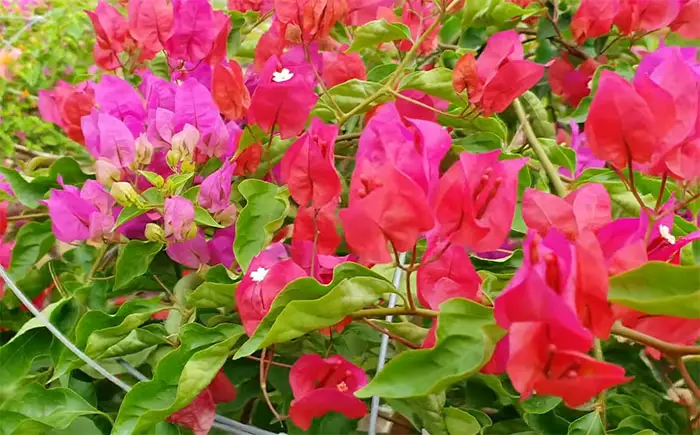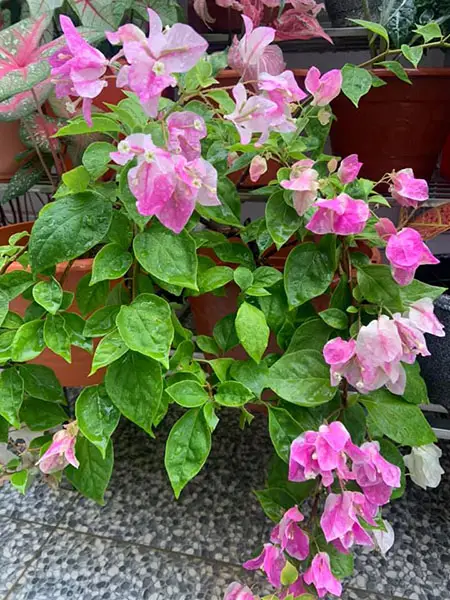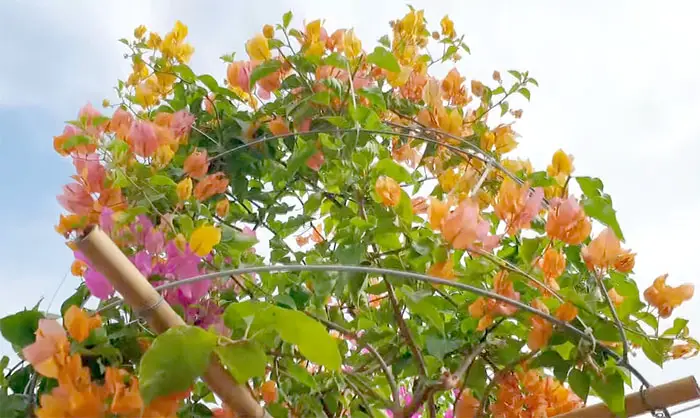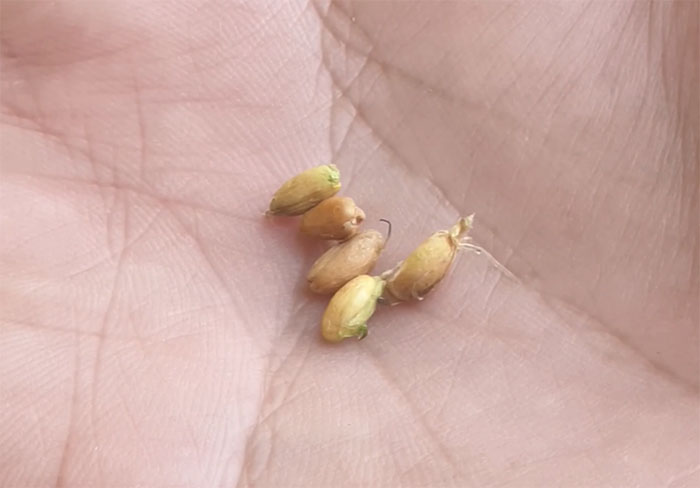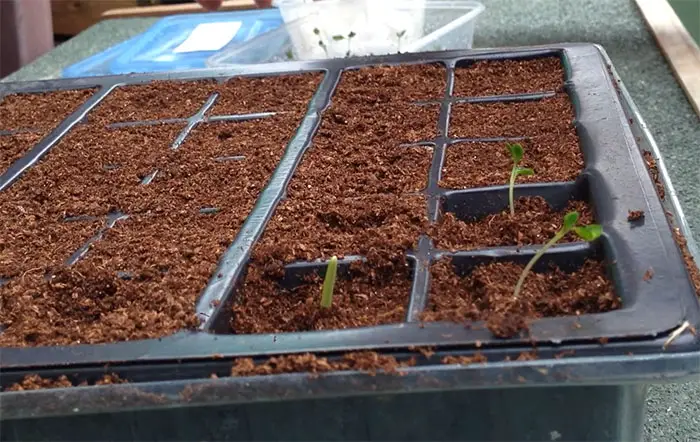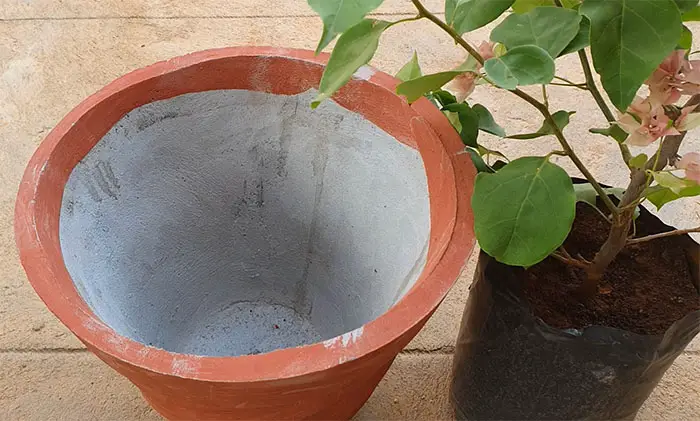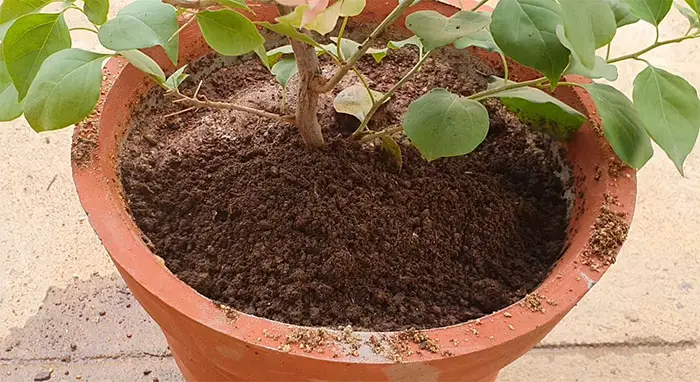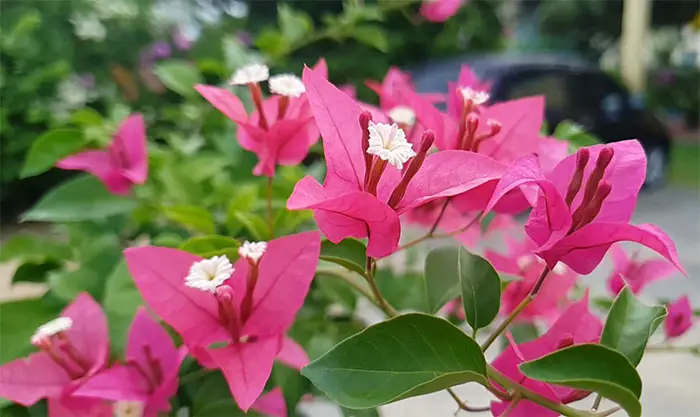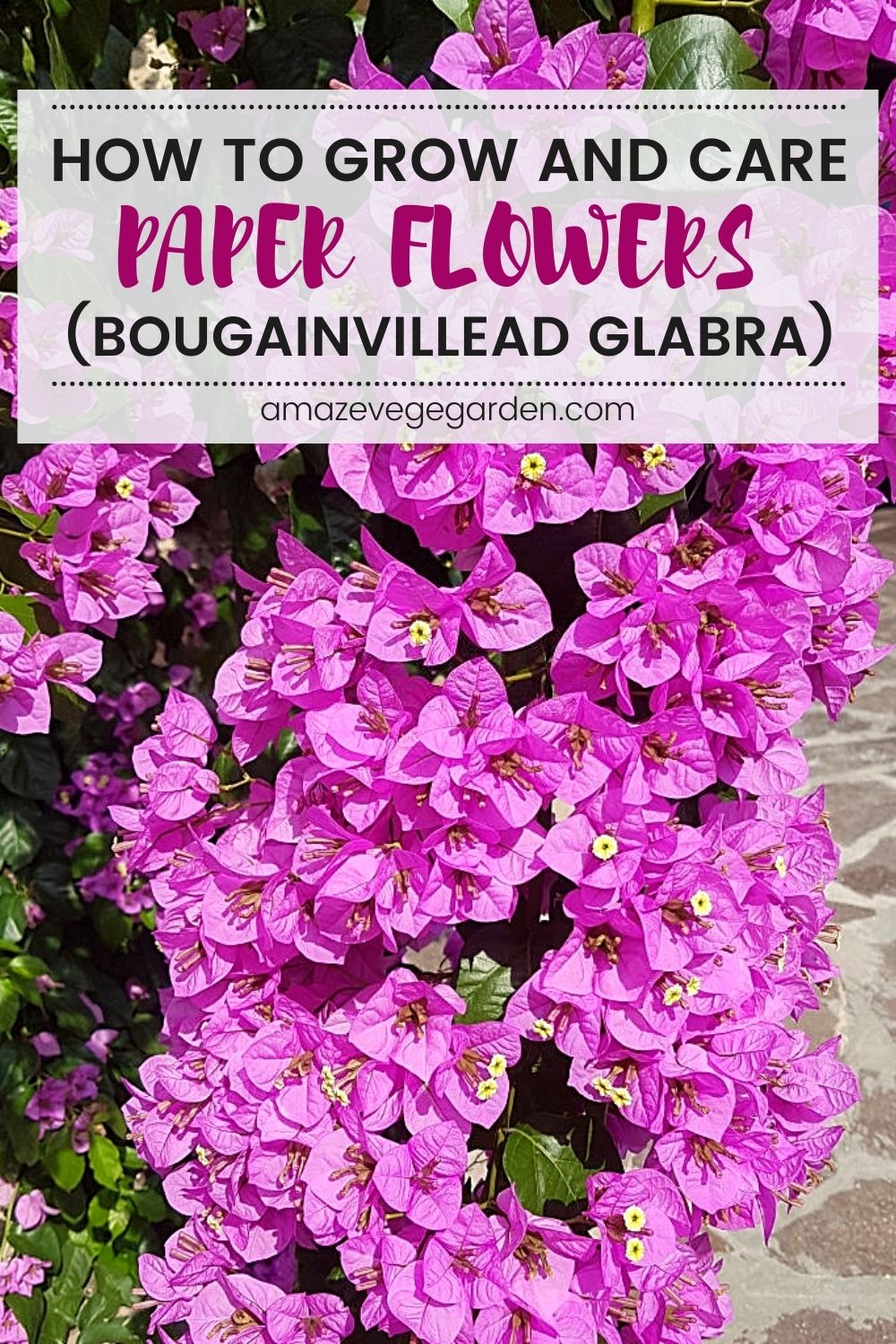In 1768, a French explorer named Louis Antoine de Bougainville, together with his botanist friend, sailed around the earth. They first discovered a large flower bud and colorful plant in the Amazon jungle of South America and named it “Bougainville.”
This is the origin of the scientific name of bougainvillea, which is transliterated as a “treasure towel flower.” Now many people also call Bougainville Glabra a paper flower.
Which Flower is Known as Paper Flower?
Paper flower is one the most colorful and memorable flowers on the planet. Once you see it, you will remember it for the rest of your life because it is so bright. They are evergreen vines with beautiful bracts. Because the paper flower is a climbing vine, you must plant it with support. Most gardeners will design the support and climbing direction before planting.
Many people use paper flowers for fence planting, and I have also seen people diligently pruning and planting them as shrubs. Some people even used them as ground covers. Potted paper flower is also suitable for hanging basket planting because the drooping branches and leaves can be gorgeous.
Characteristic of the Flower
To identify the paper flower, there are some characteristics of the flower you can look into. The bud of the flower is as thin as paper and feels like paper when you touch it. The buds are from bottom to top, with multi-layer flower clusters. The overlapping layers of flowers are very charming.
For some paper flowers, the buds evolved from leaves, so the shape of the bracts will be like leaves. The flower shape resembles a plum, with three small flowers gathered into clusters. It is forming a triangular symmetrical arrangement.
Paper flowers love to grow in environments with high dryness and good drainage. The flower is heat resistance, cold resistance, barren resistance, pruning resistance, wind resistance, drought resistance, and anti-pollution.
If you take a closer look at the flower, you will see a little white flower inside. The petals that surrounded the flowers are similar to poinsettia. The bract is to call attention to the pollinators for the existence of the flowers.
Some varieties have thorns on their stems. For these varieties, you need to be careful when passing by. It would be best if you avoided the flowers from scratching your clothes or your skin.
Is Paper Flower a Perennial Flower?
A paper flower is a perennial vine where it can be seen in clusters throughout the year. It can grow to as high as 30 feet. The bracts tend to blossom on new branches from May to December.
Its flowers are diverse and colorful, and the flowering period is more than 6 months. Planting paper flowers with different flowering periods can let you enjoy flower viewing throughout the year.
Planting paper flowers can be used as green corridors, wall decorations, potted flowers, and bonsai. If you live in a warm area, you can plant them on the ground as a hedge.
Paper flower belongs to the Mirabilis family and is a woody vine or shrub. It can grow in any environment as long as there is no stagnant water. It likes to have a lot of sun. The slender stems and branches can be bent, the branches and leaves are lush, and they are often pruned into various shapes.
It is a rare and good material in garden landscaping plants so you can see it everywhere. The plant can be used for medicinal purposes as well.
How To Grow Paper Flowers?
Here I would like to show you how to grow paper flowers from seeds and repot them when they start growing.
Grow Paper Flower From Seeds
To grow a paper flower from seeds, first, you need to collect the seeds and germinate them.
You need to know that seed is rather rare for paper flowers. Some varieties won’t have seeds at all. Some common varieties that can produce seeds are Chitra, Formosa, Refulgence, and Glabra. Generally, you can find the seed inside the bracts.
Once you collect the seeds, you can put them on cotton or tissue paper. Then put a small amount of magnesium sulfate to expedite the germination process.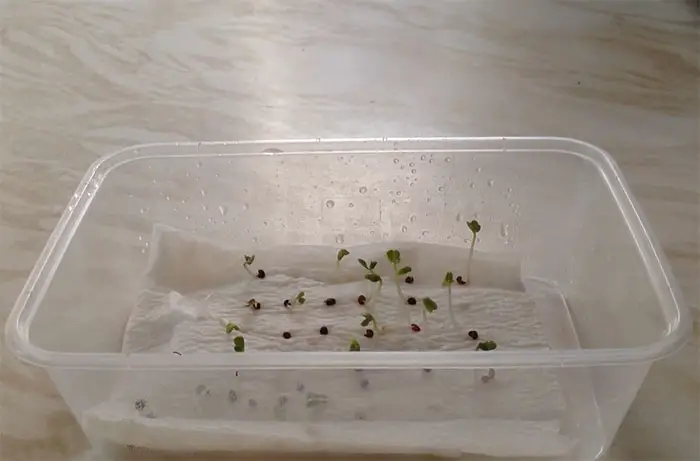
You can spray some water on it, then leave it for 2-3 days. After 2-3 days, the seeds will start to sprout. Move the sprout to a seed tray. The seed tray should contain 50% vermicompost, 30% native soil, and 20% sand.
The seed may take 15-35 days to germinate. After 3 months, the plant will grow to about 1 foot tall. You can then repot it to a larger pot or transplant it to your garden.
Transplant The Plant Outdoor
Also, instead of growing paper flowers from seeds, which will take a lot of time, you should get the potted paper flowers selling at your local garden store. You can then grow them in your yard or garden.
Before growing the flowers, you need to prepare the area. You need to ensure there is enough space for paper flowers to grow.
When you plant the paper flower in your garden, you can dig a hole and make sure you leave some extra room on the sides and beneath. To check the placement of the plant, you can place it inside the hole, and then you can gauge if you need to make it a little bit wider or deeper.
To get your plant out of the container, the easiest way is to flip it upside down. Grab it by the container and shake it a little bit, and it should ease out.
These plants will grow roots. So if you have a house foundation nearby, you need to make sure that you give them enough room in between.
Sunlight
Paper flowers can grow healthily and bloom in large numbers if exposed to the sun for more than 6 hours a day. If they do receive not enough sun, there will be fewer blooms. It needs a light level of at least 4000 FC and must be protected from frost.
The potted paper flower should be kept at a distance of more than 35 cm so that the branches and leaves on the side of the paper flower can get enough sun. In short, the more sun the plant receives, the better it will grow.
If you grow paper flowers outdoors, you need to know that the plant is drought-tolerant and drought-loving.
Temperature
The suitable temperature to grow paper flowers is 15°C – 35°C. Places with strong sunlight and a warm climate are the best environmental conditions for the plant.
If the weather condition is not good, long-term storms are expected. It would help if you took precautions to protect the plant from flooding.
Soil Conditions
To grow the plant, you need to use light soil media. The suitable soil ratio for potting is sandy loam (mud content about 20-30%): peat soil: vermiculite = 1:1:1. The ideal soil mix for planting in the ground is 50% native soil and 50% garden soil.
It would help if you didn’t plant it in low-lying places to avoid stagnant water. It is more permeable in sandy soil to increase drainage.
If it is a potted plant, the pot’s drainage hole should be large enough so that it won’t block the water from flowing through.
Water
Giving too much or too little water to paper flowers is not appropriate. You can dry the topsoil of the potted plant until the soil is 2 cm deep before it needs to be watered. Each time you water the pot, you need to water it until there is water flowing out of the bottom of the pot.
Fertilizing
A paper flower is a plant that is tolerant to poor soil. However, to bloom well, proper fertilization is required. The nutrient that is much needed by paper flowers would be nitrogen and potassium. Nitrogen promotes growth, and potassium promotes flowering. You should provide less fertilization in winter or during and close to the flowering period.
Most paper flowers are grown by propagating from cuttings. Here is the article that talks about propagating paper flowers from cuttings.
How to Take Care of Paper Flower Plant?
When potting, you must change to larger pots gradually. But remember, don’t use a large pot at one time because too much soil in the pot when the roots are not fully grown can easily make the water stagnant and cause the roots to rot.
In addition, if you want your paper flower to bloom, you need to pressure the plant. The plant will flower sooner if you make the roots more crowded and create a more difficult environment.
In contrast, if you give too much care to the plant and make it too comfortable. Then the less bloom and flowering the plant is going to be.
Paper flower is very suitable to be bonsai. You can start to grow it with a small pot, and there is no need for you to change it to a large pot if it is not necessary.
Even if it is changed to a larger pot, it should be only one size larger. This is because the more pressure you give to the plant, the better the plant grows.
But you need to water the plant diligently. This is because the amount of pot soil is tiny. Make sure the potting soil is not fully dried, and you are good to go.
Watering
As we know paper flower doesn’t need a lot of water, therefore you don’t need to water the plant every day. Especially during winter, you may need to water the plant once every 2-3 weeks. The plant prefers infrequent deep watering instead of frequent shallow watering.
Fertilizing
Don’t oversupply nitrogen to the plant. This may cause the plant to grow branches only without blooming. If you want to fertilize, it is best to apply more potassium instead of nitrogen.
Diseases
When the paper flower is planted outdoors, there are almost no pests and diseases you will find on it. If there are pests like aphids found on the plant, you can use Neem oil to get rid of them.
Pruning The Plant
The pruning of paper flowers is essential because the flowers only bloom on new branches. The consequence of not pruning is that there will be fewer and fewer flowers, or even no flowers bloom on the plant.
Pruning can also cause more new shoots to grow, making plants denser and more prosperous. Some people shave the whole plant’s head in spring, just like planting roses. Then wait for the new branches to give birth, and then pinch the upper part to promote the growth of more new branches. The two-pronged approach will make the plant a lusher.
In the summer of its peak season, it will draw out long branches. The long branches that come from the main stem will quickly grow thicker and longer.
Since the long branches will consume many nutrients and distort the plant’s shape, they should be cut quickly.
After cutting the long branches, spraying dwarfing agent (PP-333) can prevent the long branches from being extracted again.
Paper flower is easy to extract long branches if there is insufficient sunlight or too much water. You can alleviate the situation by spraying dwarfing agents (PP-333, 50-100 ppm).
Steps to Propagate a Paper Flower Plant From a Cutting
Step 1: Get the cutting ready
The first step in growing a paper flower plant from a cutting is to choose a healthy stem from the parent plant. The stem should have multiple nodes, which are tiny bumps where leaves sprout and are at least six inches long. Just below a node, cut the stem at a 45-degree angle with a clean, sharp pair of pruning shears.
Step 2: Get rid of the foliage
Remove all the leaves from the stem other than the top few after taking your cutting. This will enable the cutting to concentrate its efforts on developing roots rather than keeping its leaves alive.
Step 3. Apply rooting hormone
Then, sprinkle rooting hormone powder over the cutting’s base. By promoting root growth in this way, you’ll improve your odds of success.
Step 4: Plant the cutting
Make a hole in the middle of a tiny pot, then fill it with dirt that drains properly. Fill the hole with the cutting, then carefully push the earth around it. To build a little greenhouse, thoroughly water the cutting and cover the pot with a clear plastic bag.
Step 5: Watch and wait
Put the pot somewhere warm and bright, but out of direct sunlight. Cuttings of paper flower plants require warmth and humidity to successfully take root. Check the cutting every few days to ensure it’s still healthy and keep the soil moist but not soggy.
Steps to Transfer Paper Flower Plant Cuttings to Soil
Bougainvillea cuttings typically take 4–6 weeks to take root, though this can vary depending on storage circumstances. The optimal time to take cuttings is while the plant is actively developing, which is often in the spring or summer.
Anyway, after 4-6 weeks, your paper flower plant cutting should have developed a healthy root system. It’s now ready to be transferred to the soil.
Step 1: Prepare the soil
Fill a larger pot with well-draining soil. You can also add some organic fertilizer to the soil to give the cutting a nutrient boost.
Step 2: Transplant the cutting
Remove the plastic bag from the original pot and gently remove the cutting from the soil. Be careful not to damage the roots. Place the cutting in the new pot and cover the roots with soil. Water the plant well and place it in a warm, bright location.
Step 3: Monitor and care for the new plant
Your cutting of the paper flower plant needs close monitoring and careful care now that it has been planted in the soil. Be sure the soil is never soggy, and give the plant lots of light. It’s possible that you’ll need to prune the plant as it develops to keep it looking as good as possible.
Why is Paper Flower Not Blooming?
Many gardeners face issues where their paper flowers are not blooming. The reasons may be:
- First, the soil is too fertile, making the branches and leaves luxuriant and difficult to bloom.
- The other reason is the lack of sunshine, and the soil is too wet, resulting in excessive growth of the plant without flowering.
The prevention method is to remove long branches and reduce watering. Also, you can increase sunshine and apply a little nitrogen fertilizer.
Potted planters need to pay special attention to watering. You should be less water during the end of spring and the beginning of summer. This will make the plant reach the edge of wilting. By then, you can prune the plant, and it will bloom with gorgeous flowers.
Did you find this post useful? Would you like to get back to it later? Save THIS PIN below to your flower or gardening boards on Pinterest! Thanks

